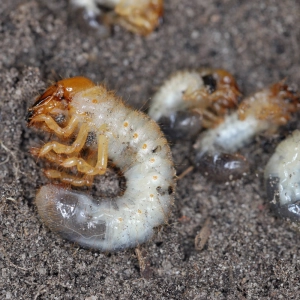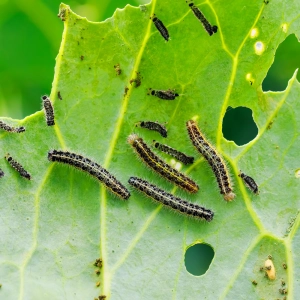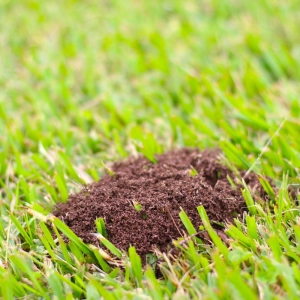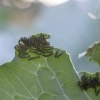
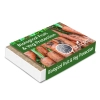
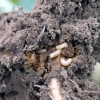
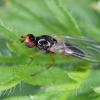
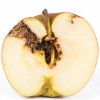
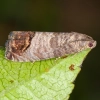
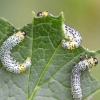
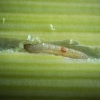
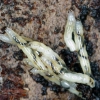

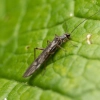
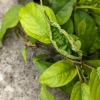

Fruit & Veg Protection
- PLEASE NOTE: All live predator products will take up to 7 working days to arrive.
- Suitable for use in organic gardens – chemical free.
- 100% safe for children, pets, earthworms, bees and birds.
- Easy application through a watering can.
- Harmless to earthworms, bees and birds.
- No impact on other biological controls.
Full Description
Our Biological Fruit and Veg Protection will help control many fruit and vegetable pests in just one product. It contains a mix of species of nematodes including Steinernema feltiae and Steinernema carpocapsae which are naturally occurring microscopic worm-like organisms that act as natural pest controls.
This product is effective on many commonly occurring pests including:
- carrot root fly
- cabbage root fly
- cutworms
- onion fly
- sciarid fly
- shore fly
- caterpillars
- gooseberry sawfly
- thrips
- codling moth
Identifying Fruit and Veg Pest Problems
-
Cutworms are the caterpillars of some moths. They live in the soil and feed on the lower stems of plants and seedlings, lettuce roots, tubers and other root vegetables - sometimes severing roots completely at ground level They grow to around 4cm in length and range in colour from cream/green to brown/grey, curling when disturbed.
-
Carrot root flies are around 8mm in length and are shiny black, with cream-coloured larvae. These larvae feed on the roots of the host plant (including carrots, parsley, parsnips, celeriac and celery) causing wilting, discolouration to outer leaves, stunting and occasionally complete plant loss. They can cause produce to be inedible.
-
Cabbage root flies can be found in many cabbage family crops and flowers. Like the carrot root fly larvae, their larvae feed on the roots of the affected plants and also on the lower sections of the plant itself. They will create tunnels in the root neck and main root which can lead to stunting, reduced yield, yellowing leaves and sometimes complete plant loss.
-
Onion flies can be mistaken for small house flies as they are similar in appearance. Their larvae grow to around 8mm and are creamy white in colour. They feed on the roots, leaves and bulbs of a range of plants from the onion family including onions, leeks, garlic and alliums - causing yellowing wilting leaves, and often killing rows of seedlings.
-
Sciarid flies are small midge like flies that can easily be seen hovering around the surface of the soil. Sometimes known as fungus flies or fungus gnats, their larvae are white and maggot like with black heads. They will eat through the roots and low stems of young plants which can go on to cause rot.
-
Shore flies are similar in appearance to sciarid flies though they are stouter with shorter antennae. They transmit plant diseases rather than feeding on the plants themselves and can affect produce grown in a greenhouse. They will deposit frass on the leaves and flowers of fruits and vegetables which can cause cosmetic issues.
-
Caterpillars will eat the leaves and young shoots of a variety of fruit and vegetable plants. They have the capacity to eat through a large volume of plant material and can easily decimate an entire plant. They can also destroy the flowers, fruits and growing tips of plants and leave frass behind spoiling the cosmetic appeal of produce.
-
Gooseberry sawflies generate larvae that will feed on the leaves of gooseberry and red/white currant plants, reducing fruit yield. There are a range of gooseberry sawflies whose larvae can vary in appearance, from the common gooseberry sawfly grub – 20mm long with pale green bodies and black spots, to the small gooseberry sawfly whose larvae are about 5mm long, and black with pale yellow legs.
-
Thrips are small insects usually not larger than 2.5mm. Their larvae and the adults feed on all parts of the plant with the young larvae usually starting on the underside of the leaves. The adults will develop wings and are usually slender in shape with long narrow wings fringed with fine hairs. Most are brown or black. Damage includes stunted and distorted growth, scarring and discolouration.
-
Codling moth caterpillars can damage a range of fruit including apples, pears, quince and walnuts. They will feed inside the developing fruits making tunnels and leaving excrement on the outside of the fruit. Affected fruits can be distorted, stunted and discoloured, and often drop early.
What is Biological Fruit and Veg Protection
Biological controls are non-chemical treatments that rely on the natural enemies of pests. Nematodes can be very successful in controlling many of the pests listed here that can cause significant damage to fruit and vegetable crops.
Nematodes are microscopic worms that actively seek out the caterpillars and larvae of various pests. They feed and multiply inside the larvae, infecting them with a bacterium. Once infected, the larvae will stop feeding and die. The nematode will then go on to seek out more, repeating the cycle.
Biological controls are a highly effective, safe treatment and are an ideal choice for organic gardeners. Biological fruit and veg protection can be used on all home-grown produce with confidence as it leaves no chemical residue. Fruit and vegetables can simply be rinsed with water before eating.
How Many Nematodes Do I Need
We sell biological fruit and veg protection in packs that cover the following areas:
- 60m2
- 120m2
There are millions of microscopic nematodes in each pack – carefully worked out to ensure accurate application for each specific area listed. Nematodes are supplied as an easy-to-mix powder which needs to be diluted with water before use. Specific dilution rates are shown in the table below.
How to Apply Nematodes
Apply to moist compost/soil, when the soil temp is above 10ºC using a watering can or sprayer.
|
Pack size |
Dilution rate |
Application instructions |
|
60m2 |
1 pack of nematodes fills 8 watering cans or 8 sprayers with 5L of water to treat 60m2 or 16 trees in 40L of water. |
For a soil drench: Dissolve the entire contents of the pack in a bucket containing 4L of water to create a stock solution. Stir vigorously.
Take out 500ml of the stock solution and add to a watering can with 4.5L of water.
Apply this solution as a soil drench to cover 7.5m2. Repeat these steps until all of the stock solution has been used and 60m2 have been treated.
For a foliar spray: Wet foliage before application. Dissolve the entire contents of the pack in a bucket containing 4L of water to create a stock solution. Stir vigorously.
Take out 500ml of the stock solution and add to an empty pump sprayer with 4.5L of water.
Apply this as a foliar spray to an eighth of the area. Repeat these steps until all of the stock solution has been used and 60m2 have been treated.
For codling moth: Wet the soil and bark beneath the tree. Dissolve the entire contents of the pack in a bucket containing 4L of water to create a stock solution. Stir vigorously.
Take out 500ml of the stock solution and add to an empty pump sprayer with 4.5L of water. Apply this as a soil and tree drench to up to two trees. Repeat these steps until all of the stock solution has been used and 16 trees have been treated. |
|
120m2 |
1 pack of nematodes fills 8 watering cans or 16 sprayers with 5L of water to treat 120m2 or 32 trees in 80L of water |
For a soil drench - Dissolve the entire contents of the pack in a bucket containing 8L of water to create a stock solution. Stir vigorously.
Take out 500ml of the stock solution and add to a watering can with 4.5L of water. Apply this solution as a soil drench to cover 7.5m2.
Repeat these steps until all of the stock solution has been used and 120m2 have been treated.
For a foliar spray: Wet the foliage before application. Dissolve the entire contents of the pack in a bucket containing 8L of water to create a stock solution. Stir vigorously.
Take out 500ml of the stock solution and add to an empty pump sprayer with 4.5L of water. Apply this as a foliar spray to 7.5m2. Repeat these steps until all of the stock solution has been used and 120m2 have been treated.
For codling moth: Wet the soil and bark beneath the tree. Dissolve the entire contents of the pack in a bucket containing 8L of water to create a stock solution. Stir vigorously.
Take out 500ml of the stock solution and add to an empty pump sprayer with 4.5L of water. Apply this as a soil and tree drench to up to two trees.
Repeat these steps until all of the stock solution has been used and 32 trees have been treated. |
Our Recommendation
When to Apply Biological Fruit and Veg Control
You can apply these nematodes when the soil temperature is above 10°C.
Nematodes are particularly effective in damp, wet weather. Try and choose a humid or wet day to apply the nematodes. They are UV-sensitive so it is best to avoid applying them on a bright sunny day as they will not survive in these conditions. The best humidity levels are often first thing in the morning or late afternoon
Can I Store Nematodes?
Nematodes are perishable and need to be applied quickly after delivery for best results. They can however be stored in the fridge for up to two days. Please note that delivery can take up to two weeks.
Technical Specification
| Product | Fruit & Veg Protection |
|---|---|
| Brand | |
| Period Of Use | Spring, Summer, Autumn |
| Active Ingredient | Various nematode species |
| Application Method | Knapsack, Watering Can |
| Pack Size Coverage | Up to 120m² |




